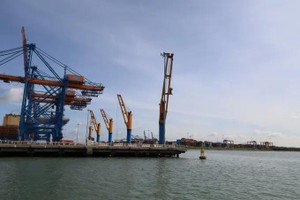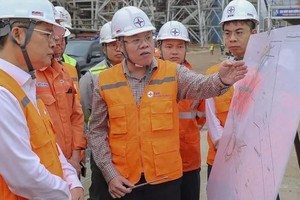
The report by the Ministry of Finance also showed that in the period from 2016 to 2018, 159 enterprises have been given nods to their equitization plans with total value of VND442.27 trillion, of which state capital was nearly VND206 trillion. However, if including the first nine months of this year, there were only 168 enterprises having been greenlighted for their equitization plans with total value of VND443.05 trillion, of which the value of state capital was nearly VND206.7 trillion, just nine enterprises higher.
Only nine enterprises have been approved privatization plans within nine months. However, it is a long way from passing approval to completing equitization. Because in fact, many enterprises failed to sell their shares before deadline so they had to appraise and approve the plan from the beginning. Of which, only three out of nine enterprises were approved equitization plans for the first time while the rest was moved from previous stage.
Similarly, among 168 equitized enterprises, only 36 out of 128 enterprises were in the equitization category in accordance with the Official Dispatch No.991 and Decision No.26/2019 by the Prime Minister, achieving 28 percent of the plan. Therefore, the number of enterprises which have to carry out equitization by the end of 2020 was 92 enterprises.
With such remaining number of enterprises, equitization from the beginning of this year has just reached an odd number, nearly 10 percent. There is high possibility that equitization will fail to meet the progress by 2020. Ho Chi Minh City with 38 enterprises is the city with the highest number of enterprises, which must be equitized, of which there are 11 corporations, accounting for 40 percent of the plan. Hanoi has 13 enterprises, of which there are four corporations. The Committee for Management of State Capital at Enterprises has six enterprises and the Ministry of Industry and Trade has four enterprises.
According to statistics, since 2016 to September this year, the State has divested around VND24.5 trillion, collecting around VND170.6 trillion. Meanwhile, the Decision No.1232/QD-TTg signed by the Prime Minister, approving divestment of state-owned enterprises in the period from 2017 to 2020, in which, the target for this period is to divest VND60 trillion of state capital at enterprises.
However, until now, nearly VND4 trillion of state capital at 78 enterprises have been divested, bringing in more than VND7.1 trillion. Meanwhile, divestment efficiency at enterprises outside the Decision No.1232/QD-TTg was higher as the State earned nearly VND110.4 trillion for divesting only VND3.78 trillion. For instance, divestment at Sabeco for VND3.43 trillion brought back VND109.96 trillion; and divestment at Vinamilk for nearly VND1 trillion also brought back nearly VND3 trillion.
The reason for sluggishness in equitization and divestment was because that most of enterprises are large companies with complicated financial state and lots of land ownership, or enterprises operating in public service sector, closely linking to local activities, playing an important role in ensuring implementation of strategies and targets about local social security.
However, there was also subjective reason that some enterprises are under investigation and some do not want to divest from industries and sectors with high growth and profitability.
Therefore, the Prime Minister instructed that equitization, divestment and restructuring of state-owned enterprises must be publicized, transparent, in compliance with the law, complied with market regulations and avoid interest group phenomenon. Besides, regulations and legal framework on the management and operation of state-owned and state-invested enterprises on equitization, divestment and restructuring of enterprises will continue to be completed.
Only nine enterprises have been approved privatization plans within nine months. However, it is a long way from passing approval to completing equitization. Because in fact, many enterprises failed to sell their shares before deadline so they had to appraise and approve the plan from the beginning. Of which, only three out of nine enterprises were approved equitization plans for the first time while the rest was moved from previous stage.
Similarly, among 168 equitized enterprises, only 36 out of 128 enterprises were in the equitization category in accordance with the Official Dispatch No.991 and Decision No.26/2019 by the Prime Minister, achieving 28 percent of the plan. Therefore, the number of enterprises which have to carry out equitization by the end of 2020 was 92 enterprises.
With such remaining number of enterprises, equitization from the beginning of this year has just reached an odd number, nearly 10 percent. There is high possibility that equitization will fail to meet the progress by 2020. Ho Chi Minh City with 38 enterprises is the city with the highest number of enterprises, which must be equitized, of which there are 11 corporations, accounting for 40 percent of the plan. Hanoi has 13 enterprises, of which there are four corporations. The Committee for Management of State Capital at Enterprises has six enterprises and the Ministry of Industry and Trade has four enterprises.
According to statistics, since 2016 to September this year, the State has divested around VND24.5 trillion, collecting around VND170.6 trillion. Meanwhile, the Decision No.1232/QD-TTg signed by the Prime Minister, approving divestment of state-owned enterprises in the period from 2017 to 2020, in which, the target for this period is to divest VND60 trillion of state capital at enterprises.
However, until now, nearly VND4 trillion of state capital at 78 enterprises have been divested, bringing in more than VND7.1 trillion. Meanwhile, divestment efficiency at enterprises outside the Decision No.1232/QD-TTg was higher as the State earned nearly VND110.4 trillion for divesting only VND3.78 trillion. For instance, divestment at Sabeco for VND3.43 trillion brought back VND109.96 trillion; and divestment at Vinamilk for nearly VND1 trillion also brought back nearly VND3 trillion.
The reason for sluggishness in equitization and divestment was because that most of enterprises are large companies with complicated financial state and lots of land ownership, or enterprises operating in public service sector, closely linking to local activities, playing an important role in ensuring implementation of strategies and targets about local social security.
However, there was also subjective reason that some enterprises are under investigation and some do not want to divest from industries and sectors with high growth and profitability.
Therefore, the Prime Minister instructed that equitization, divestment and restructuring of state-owned enterprises must be publicized, transparent, in compliance with the law, complied with market regulations and avoid interest group phenomenon. Besides, regulations and legal framework on the management and operation of state-owned and state-invested enterprises on equitization, divestment and restructuring of enterprises will continue to be completed.
























